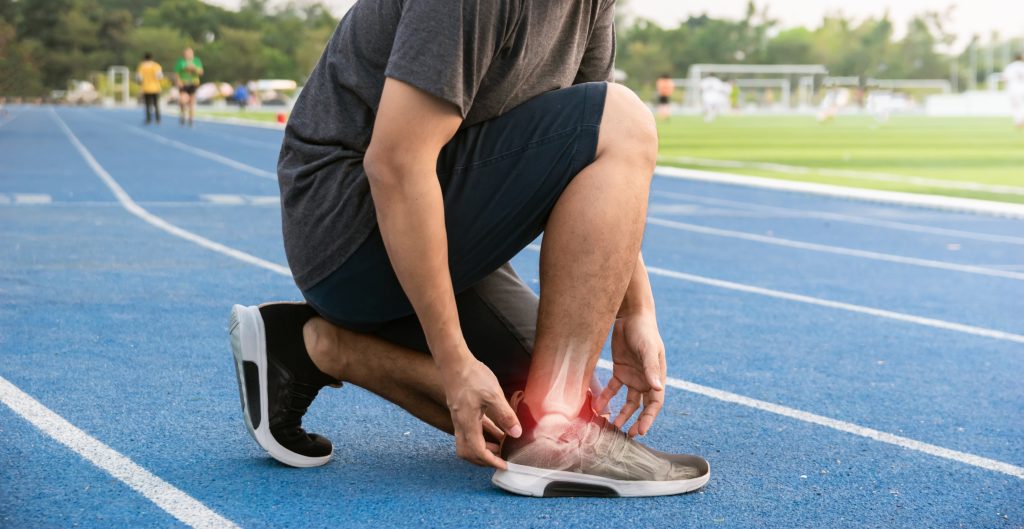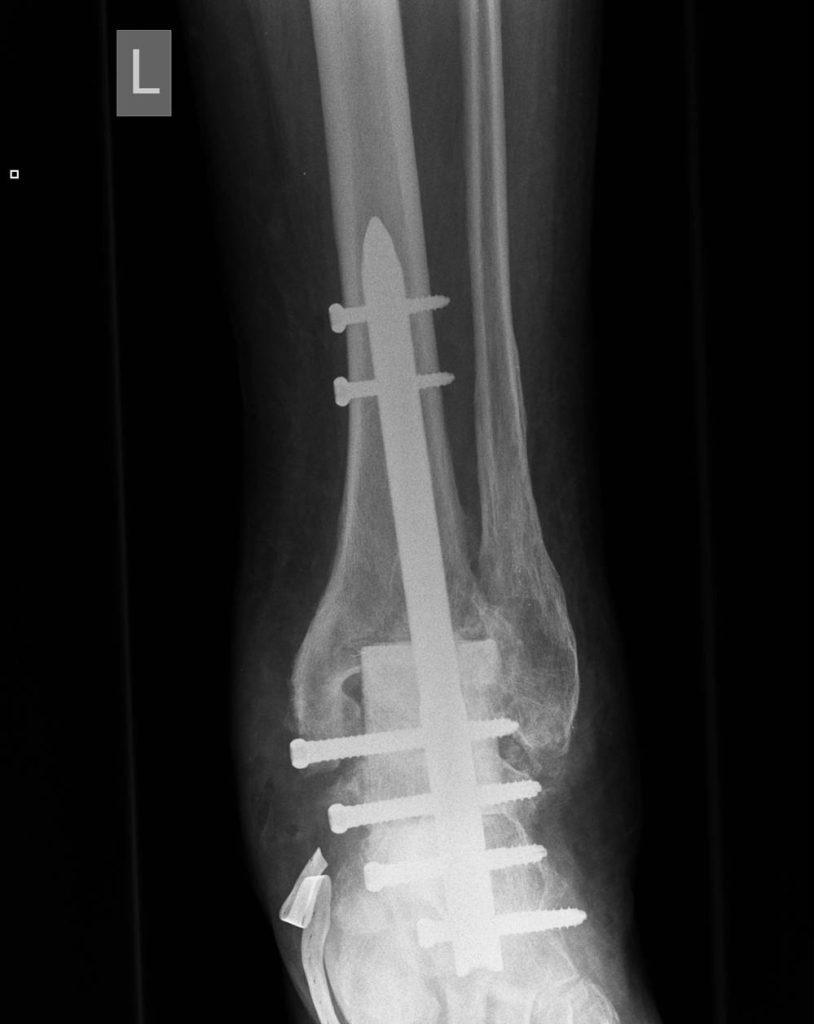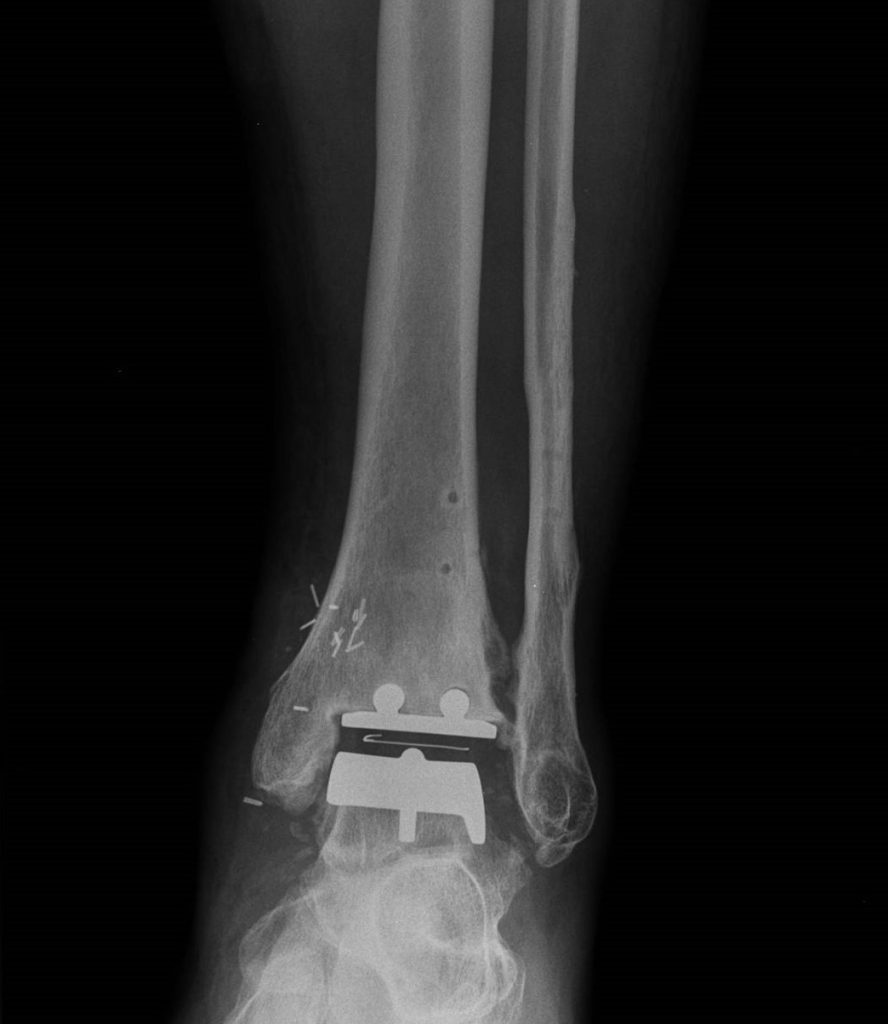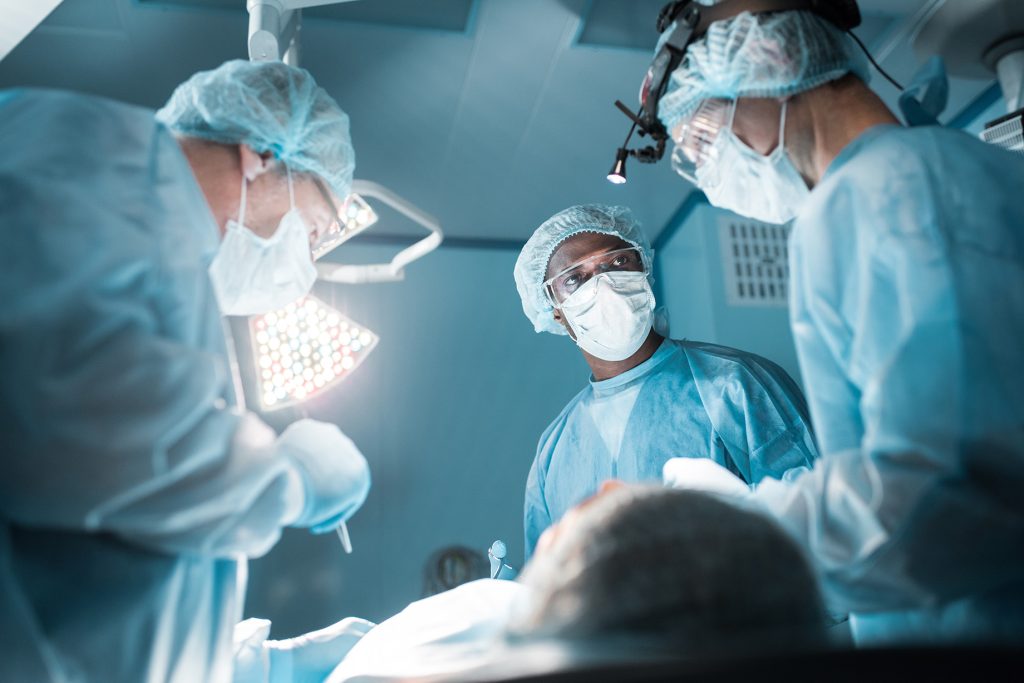Artificial ankle joint
The ankle joint – It is the most frequently injured large joint of the lower extremity, bears the greatest load per unit area and has the thinnest cartilage. Nevertheless, osteoarthritis (wear and tear) is less common here than in the knee or hip joint, as the cartilage cover is more resilient and resistant. If ankle arthrosis does occur, it can lead to severe pain and restrict mobility. An ankle joint prosthesis helps to maintain the mobility of the joint.
Causes of ankle joint wear and tear
The most common causes of ankle wear are post-traumatic conditions and rheumatism. There are also other factors that can promote wear and tear of the ankle joint. These include obesity, repeated overloading of the joint through certain sports or activities, age-related changes in the joint cartilage and genetic predisposition.
Depending on the progression of the disease, pain in the foot, swelling, redness and even joint stiffness may occur. Prompt treatment by a doctor is necessary to avoid consequential damage.

Treatment of wear and tear
If the wear and tear of the ankle joint is not yet so advanced, conservative treatment options are initially used to alleviate the symptoms and improve the function of the joint. Non-surgical treatment includes analgesics and anti-inflammatory drugs, activity modifications, physiotherapy, orthoses (braces) and intra-articular injections.
Operational options
If the wear is already severe and the patient has significant problems, surgical treatment is the next step after conservative therapy has been exhausted.

1. stiffening
Surgical treatment of osteoarthritis of the upper ankle joint in the final stage is traditionally carried out by arthrodesis (“fusion”, “screwing”), which is performed by fusing the affected joints to prevent movement between the bones and thus eliminate the wear and tear. Although the patient is usually pain-free afterwards , the ankle joint loses mobility. This can severely restrict the patient’s quality of life.
2. ankle joint prosthesis
Ankle replacement (total ankle arthroplasty) is nowadays a very good alternative to arthrodesis. Minimally invasive, possibly arthroscopically assisted ankle joint strengthening has recently become increasingly popular. Joint replacement with an endoprosthesis offers the advantage of preserving the mobility and function of the joint. This can also lead to an improvement in gait, including a reduction in limping, and protection of other joints.
The likelihood of a follow-up operation after an artificial joint is just as high as after a hardening of the ankle joint. The main disadvantage of hardening the ankle joint is the restriction of movement in the joint and thus the overloading of the ankle joints with every step, which over the years leads to wear and tear and the development of pain.
Development of the prosthesis
The first ankle joint endoprosthesis was performed by Lord and Marrotte in 1970. These were artificial joints of the first generation, which were characterized by a high complication rate. In the 1980s, second-generation endoprostheses came to the fore, the results of which were already significantly better, but still lagged behind the results of hip or knee replacements. Only the third generation of artificial joints developed in the 1990s achieved very good results and are still implanted today. They consist of three parts, are cement-free and perfectly anatomically shaped.
Patient expectations
Modern artificial ankle implants meet patients’ expectations, as the latest studies using specific evaluation systems (MODEMS expectations scale) show. Patients’ expectations (not least due to the influence of the Internet) are constantly rising and are higher before artificial joint surgery than before joint strengthening (arthrodesis). After the operation, there is a significant reduction in pain, which enables an increase in physical activity both at work and during leisure time, as well as an improvement in the quality of sleep. According to these studies, patients are more satisfied after an artificial joint than after an ankle arthrodesis.

Optimal preparation for successful ankle endoprostheses
Optimal preparation for successful ankle endoprostheses
However, a prerequisite for a good result after the endoprosthesis is a detailed knowledge of the anatomy of the ankle joint and its perfect restoration with an endoprosthesis. Before an artificial joint operation, a series of necessary imaging examinations (special X-rays, MR, CT, SPECT-CT) must be carried out so that the surgeon receives comprehensive information about the operated joint. These examinations help to determine how the operation should be performed and what needs to be corrected in order to restore the original normal shape of the ankle joint.

Supplementary interventions
In addition to the actual implantation of the endoprosthesis, the surgeon often has to perform other procedures, such as Achilles tendon lengthening, calf bone lengthening, corrective ankle screw fixation or foot or lower leg repositioning, collateral ligament reconstruction, etc. The axis of the ankle joint must be corrected and the collateral ligaments must be in balance after the operation. Post-traumatic conditions in particular, which occur in the majority of cases, often place high demands on the overall reconstruction of the ankle joint.
Precise alignment and reconstruction of the foot are crucial for the long-term success of an ankle joint endoprosthesis. However, if this reconstruction is not perfect, there is a risk of the endoprosthesis failing after some time.
Frequently asked questions (FAQ) about the artificial ankle joint
Here you will find answers to the most frequently asked questions about artificial ankle joints. Find out more about the operation, the healing process, possible risks and whether an ankle joint prosthesis is the right choice for you. This information is intended to help you make an informed decision about the treatment of ankle arthrosis or other joint diseases and find the best possible treatment option.
What is an artificial ankle joint?
An artificial ankle joint, also known as an ankle joint prosthesis, is an implant that replaces the natural ankle joint. It is used in patients whose ankle joint is so severely damaged by osteoarthritis, injuries or other diseases that conventional treatment methods no longer provide sufficient pain relief and mobility.
Who is an artificial ankle joint suitable for?
An artificial ankle joint is ideal for patients who suffer from advanced osteoarthritis or irreparable cartilage damage and for whom conservative therapies such as physiotherapy, painkillers or injections are no longer effective. It is important that there are no infections in the area of the ankle joint.
How does the operation for an artificial ankle work?
The operation is usually performed under general or regional anesthesia. The surgeon removes the damaged bone and cartilage parts of the ankle joint and inserts the artificial implant. The procedure takes about two hours and the patient usually stays in hospital for the first few days.
How long does it take to heal after an artificial ankle joint has been implanted?
Full recovery can take several weeks. In the first few weeks after the operation, partial weight-bearing with walking aids is required. Intensive physiotherapeutic follow-up treatment helps to restore mobility and stability to the ankle joint. Most patients can resume normal activities after around three to four months.
What risks are associated with the implantation of an artificial ankle joint?
As with any operation, there are also risks associated with the implantation of an artificial ankle joint. These include infection, thrombosis or loosening of the prosthesis over time. I will inform you in detail about all possible complications and ensure that you are as well prepared as possible.
How long does an artificial ankle joint last?
The durability of an artificial ankle joint varies depending on the patient and their level of activity. Modern ankle prostheses can generally last for many years. Regular check-ups by the doctor are crucial to ensure the longevity of the prosthesis.
Are there alternatives to an artificial ankle joint?
Yes, in addition to the ankle joint prosthesis, there are also other treatment options, such as ankle fusion (arthrodesis) or stretching the joint on the external fixator (distraction). The first method eliminates the mobility of the ankle joint.
Can you do sports again after an ankle joint prosthesis?
After successful rehabilitation, many patients are able to resume various sports such as cycling, swimming, walking, skiing, etc.
What are the costs of an artificial ankle joint?
The cost of an ankle prosthesis can vary depending on the extent of the treatment and the implant selected. In many cases, the costs are covered by health insurance, especially if conservative treatments no longer provide relief. It is advisable to obtain individual advice from the treating doctor and health insurance provider in advance.
How does an artificial ankle joint differ from an arthrodesis (joint fusion)?
An artificial ankle joint maintains the mobility of the ankle joint, while an arthrodesis stiffens the joint to eliminate pain.
If you have any further questions about the artificial ankle joint or would like a personal consultation, you can contact me directly at any time. I will be happy to take the time to discuss your individual concerns and find the right treatment for you. Simply make an appointment so that we can discuss the best options for your ankle together!
Conclusion
If you have a worn ankle joint, if you are in pain or if you want a movable joint and not a screwed joint, contact me with a request for an artificial joint. I have 25 years of experience with the implantation of these endoprostheses in the most difficult conditions.